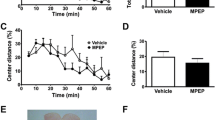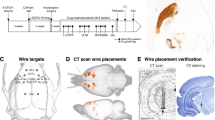Abstract
Lesions of nigrostriatal dopaminergic neurons as seen in Parkinson’s disease (PD) increase orofacial responses to serotonergic (5-HT) agonists in rodents. Although this response to 5-HT agonists has been related to aberrant signalling in the basal ganglia, a group a subcortical structures involved in the control of motor behaviours, it deserves additional studies with respect to the specific loci involved. Using measurements of orofacial activity, as well as single-cell recordings in vivo, we have studied the role of the entopeduncular nucleus (EPN; equivalent to the internal globus pallidus of primates), an output structure of basal ganglia, in the hypersensitized responses to a 5-HT agonist in sham- or unilaterally dopamine-depleted rats. Intra-EPN injections of Ro 60-0175 (0.3 and 1 μg/100 nl) promoted robust oral movements in 6-OHDA rats without affecting oral activity in sham-depleted rats. Peripheral administration of Ro 60-0175 (3 mg/kg ip) decreased EPN neuronal firing rate in 6-OHDA rats compared to sham-depleted rats. Such an effect was also observed when the agonist (0.2 μg/20 nl) was locally applied onto EPN neurons. These data demonstrate the contribution of EPN to hypersensitized responses to 5-HT agonists in a rat model of PD.




Similar content being viewed by others
Abbreviations
- 5-HT:
-
Serotonin
- 5-HT2C :
-
Serotonin(2C) Receptors
- SNr:
-
Substantia nigra pars reticulata
- SNc:
-
Substantia nigra pars compacta
- EPN:
-
Entopeduncular nucleus
- DA:
-
Dopamine
- 6-OHDA:
-
6-Hydroxydopamine
References
Adachi K, Hasegawa M, Fujita S, Sato M, Miwa Y, Ikeda H, Koshikawa N, Cools AR (2002) Dopaminergic and cholinergic stimulation of the ventrolateral striatum elicit rat jaw movements that are funnelled via distinct efferents. Eur J Pharmacol 442(1–2):81–92
Belforte JE, Pazo JH (2004) Turning behaviour induced by stimulation of the 5-HT receptors in the subthalamic nucleus. Eur J Neurosci 19(2):346–355
Beyeler A, Kadiri N, Navailles S, Boujema MB, Gonon F, Moine CL, Gross C, De Deurwaerdere P (2010) Stimulation of serotonin2C receptors elicits abnormal oral movements by acting on pathways other than the sensorimotor one in the rat basal ganglia. Neuroscience 169(1):158–170
Boraud T, Bezard E, Guehl D, Bioulac B, Gross C (1998) Effects of L-DOPA on neuronal activity of the globus pallidus externalis (GPe) and globus pallidus internalis (GPi) in the MPTP-treated monkey. Brain Res 787(1):157–160
Brotchie P, Iansek R, Horne M (1991) A neural network model of neural activity in the monkey globus pallidus. Neurosci Lett 131(1):33–36
Carta M, Carlsson T, Kirik D, Bjorklund A (2007) Dopamine released from 5-HT terminals is the cause of L-DOPA-induced dyskinesia in parkinsonian rats. Brain J Neurol 130(Pt 7):1819–1833. doi:10.1093/brain/awm082
Chase TN, Engber TM, Mouradian MM (1994) Palliative and prophylactic benefits of continuously administered dopaminomimetics in Parkinson’s disease. Neurology 44(7 Suppl 6):S15–S18
Chevalier G, Deniau JM (1990) Disinhibition as a basic process in the expression of striatal functions. Trends Neurosci 13(7):277–280
De Deurwaerdere P, Chesselet MF (2000) Nigrostriatal lesions alter oral dyskinesia and c-Fos expression induced by the serotonin agonist 1-(m-chlorophenyl)piperazine in adult rats. J Neurosci 20(13):5170–5178
De Deurwaerdere P, Navailles S, Berg KA, Clarke WP, Spampinato U (2004) Constitutive activity of the serotonin2C receptor inhibits in vivo dopamine release in the rat striatum and nucleus accumbens. J Neurosci 24(13):3235–3241
De Deurwaerdere P, Le Moine C, Chesselet MF (2010) Selective blockade of serotonin 2C receptor enhances Fos expression specifically in the striatum and the subthalamic nucleus within the basal ganglia. Neurosci Lett 469(2):251–255
DeLong MR (1990) Primate models of movement disorders of basal ganglia origin. Trends Neurosci 13(7):281–285
Di Giovanni G, Di Matteo V, La Grutta V, Esposito E (2001) m-Chlorophenylpiperazine excites non-dopaminergic neurons in the rat substantia nigra and ventral tegmental area by activating serotonin-2C receptors. Neuroscience 103(1):111–116
Di Matteo V, Pierucci M, Esposito E, Crescimanno G, Benigno A, Di Giovanni G (2008) Serotonin modulation of the basal ganglia circuitry: therapeutic implication for Parkinson’s disease and other motor disorders. Prog Brain Res 172:423–463
Dogali M, Fazzini E, Kolodny E, Eidelberg D, Sterio D, Devinsky O, Beric A (1995) Stereotactic ventral pallidotomy for Parkinson’s disease. Neurology 45(4):753–761
Eberle-Wang K, Lucki I, Chesselet MF (1996) A role for the subthalamic nucleus in 5-HT2C-induced oral dyskinesia. Neuroscience 72(1):117–128
Eberle-Wang K, Mikeladze Z, Uryu K, Chesselet MF (1997) Pattern of expression of the serotonin2C receptor messenger RNA in the basal ganglia of adult rats. J Comp Neurol 384(2):233–247
Filip M, Bader M (2009) Overview on 5-HT receptors and their role in physiology and pathology of the central nervous system. Pharmacological Rep: PR 61(5):761–777
Gong L, Kostrzewa RM (1992) Supersensitized oral responses to a serotonin agonist in neonatal 6-OHDA-treated rats. Pharmacol Biochem Behav 41(3):621–623
Gong L, Kostrzewa RM, Fuller RW, Perry KW (1992) Supersensitization of the oral response to SKF 38393 in neonatal 6-OHDA-lesioned rats is mediated through a serotonin system. J Pharmacol Exp Ther 261(3):1000–1007
Gong L, Kostrzewa RM, Li C (1994) Neonatal 6-hydroxydopamine and adult SKF 38393 treatments alter dopamine D1 receptor mRNA levels: absence of other neurochemical associations with the enhanced behavioral responses of lesioned rats. J Neurochem 63(4):1282–1290
Hassani OK, Feger J (1999) Effects of intrasubthalamic injection of dopamine receptor agonists on subthalamic neurons in normal and 6-hydroxydopamine-lesioned rats: an electrophysiological and c-Fos study. Neuroscience 92(2):533–543
Ikeguchi K, Kuroda A (1995) Mianserin treatment of patients with psychosis induced by antiparkinsonian drugs. Eur Arch Psychiatry Clin Neurosci 244(6):320–324
Ikram H, Samad N, Haleem DJ (2007) Neurochemical and behavioral effects of m-CPP in a rat model of tardive dyskinesia. Pak J Pharm Sci 20(3):188–195
Invernizzi RW, Pierucci M, Calcagno E, Di Giovanni G, Di Matteo V, Benigno A, Esposito E (2007) Selective activation of 5-HT(2C) receptors stimulates GABA-ergic function in the rat substantia nigra pars reticulata: a combined in vivo electrophysiological and neurochemical study. Neuroscience 144(4):1523–1535
Kaneoke Y, Vitek JL (1996) Burst and oscillation as disparate neuronal properties. J Neurosci Methods 68(2):211–223
Kita H, Chiken S, Tachibana Y, Nambu A (2007) Serotonin modulates pallidal neuronal activity in the awake monkey. J Neurosci 27(1):75–83. doi:10.1523/JNEUROSCI.4058-06.2007
Knight AR, Misra A, Quirk K, Benwell K, Revell D, Kennett G, Bickerdike M (2004) Pharmacological characterisation of the agonist radioligand binding site of 5-HT(2A), 5-HT(2B) and 5-HT(2C) receptors. Naunyn Schmiedebergs Arch Pharmacol 370(2):114–123. doi:10.1007/s00210-004-0951-4
Kostrzewa RM, Reader TA, Descarries L (1998) Serotonin neural adaptations to ontogenetic loss of dopamine neurons in rat brain. J Neurochem 70(3):889–898
Kostrzewa RM, Huang NY, Kostrzewa JP, Nowak P, Brus R (2007) Modeling tardive dyskinesia: predictive 5-HT2C receptor antagonist treatment. Neurotox Res 11(1):41–50
Labarre D, Meissner W, Boraud T (2008) Measure of the regularity of events in stochastic point processes, application to neuron activity analysis. 33rd IEEE International Conference on Acoustics, Speech and Signal Processing, Las Vegas, NV. pp 489–492
Lagiere M, Navailles S, Bosc M, Guthrie M, De Deurwaerdère P (2013) Serotonin2C receptors and the motor control of oral activity. Curr Neuropharmacol (in press)
Lang AE, Duff J, Saint-Cyr JA, Trepanier L, Gross RE, Lombardi W, Montgomery E, Hutchinson W, Lozano AM (1999) Posteroventral medial pallidotomy in Parkinson’s disease. J Neurol 246(Suppl 2):II28–II41
Liminga U, Johnson AE, Andren PE, Gunne LM (1993) Modulation of oral movements by intranigral 5-hydroxytryptamine receptor agonists in the rat. Pharmacol Biochem Behav 46(2):427–433
Mehta A, Eberle-Wang K, Chesselet MF (2001) Increased m-CPP-induced oral dyskinesia after lesion of serotonergic neurons. Pharmacol Biochem Behav 68(2):347–353
Mongeau R, Martin CB, Chevarin C, Maldonado R, Hamon M, Robledo P, Lanfumey L (2010) 5-HT2C receptor activation prevents stress-induced enhancement of brain 5-HT turnover and extracellular levels in the mouse brain: modulation by chronic paroxetine treatment. J Neurochem 115(2):438–449
Navailles S, De Deurwaerdere P (2012) Contribution of serotonergic transmission to the motor and cognitive effects of high-frequency stimulation of the subthalamic nucleus or levodopa in Parkinson’s disease. Mol Neurobiol 45(1):173–185. doi:10.1007/s12035-011-8230-0
Navailles S, Benazzouz A, Bioulac B, Gross C, De Deurwaerdere P (2010a) High-frequency stimulation of the subthalamic nucleus and L-3,4-dihydroxyphenylalanine inhibit in vivo serotonin release in the prefrontal cortex and hippocampus in a rat model of Parkinson’s disease. J Neurosci 30(6):2356–2364
Navailles S, Bioulac B, Gross C, De Deurwaerdere P (2010b) Serotonergic neurons mediate ectopic release of dopamine induced by L-DOPA in a rat model of Parkinson’s disease. Neurobiol Dis 38(1):136–143. doi:10.1016/j.nbd.2010.01.012
Navailles S, Lagiere M, Roumegous A, Polito M, Boujema MB, Cador M, Dunlop J, Chesselet MF, Millan MJ, De Deurwaerdere P (2013) Serotonin2C ligands exhibiting full negative and positive intrinsic activity elicit purposeless oral movements in rats: distinct effects of agonists and inverse agonists in a rat model of Parkinson’s disease. Int J Neuropsychopharmacol 16(3):593–606. doi:10.1017/S1461145712000417
Numan S, Lundgren KH, Wright DE, Herman JP, Seroogy KB (1995) Increased expression of 5HT2 receptor mRNA in rat striatum following 6-OHDA lesions of the adult nigrostriatal pathway. Brain Res Mol Brain Res 29(2):391–396
Pact V, Giduz T (1999) Mirtazapine treats resting tremor, essential tremor, and levodopa-induced dyskinesias. Neurology 53(5):1154
Parry TJ, Eberle-Wang K, Lucki I, Chesselet MF (1994) Dopaminergic stimulation of subthalamic nucleus elicits oral dyskinesia in rats. Exp Neurol 128(2):181–190. doi:10.1006/exnr.1994.1126
Pasqualetti M, Ori M, Castagna M, Marazziti D, Cassano GB, Nardi I (1999) Distribution and cellular localization of the serotonin type 2C receptor messenger RNA in human brain. Neuroscience 92(2):601–611
Paxinos G, Watson C (1998) The rat brain in stereotaxic coordinates, 4th edn. Academic Press, San Diego
Plech A, Brus R, Kalbfleisch JH, Kostrzewa RM (1995) Enhanced oral activity responses to intrastriatal SKF 38393 and m-CPP are attenuated by intrastriatal mianserin in neonatal 6-OHDA-lesioned rats. Psychopharmacology 119(4):466–473
Pompeiano M, Palacios JM, Mengod G (1994) Distribution of the serotonin 5-HT2 receptor family mRNAs: comparison between 5-HT2A and 5-HT2C receptors. Brain Res Mol Brain Res 23(1–2):163–178
Sgambato V, Abo V, Rogard M, Besson MJ, Deniau JM (1997) Effect of electrical stimulation of the cerebral cortex on the expression of the Fos protein in the basal ganglia. Neuroscience 81(1):93–112
Stewart BR, Jenner P, Marsden CD (1989) Induction of purposeless chewing behaviour in rats by 5-HT agonist drugs. Eur J Pharmacol 162(1):101–107
Sutton JP, Couldwell W, Lew MF, Mallory L, Grafton S, DeGiorgio C, Welsh M, Apuzzo ML, Ahmadi J, Waters CH (1995) Ventroposterior medial pallidotomy in patients with advanced Parkinson’s disease. Neurosurgery 36(6):1112–1116 (discussion 1116–1117)
Wolf WA, Bieganski GJ, Guillen V, Mignon L (2005) Enhanced 5-HT2C receptor signaling is associated with haloperidol-induced “early onset” vacuous chewing in rats: implications for antipsychotic drug therapy. Psychopharmacology 182(1):84–94
Zhang X, Andren PE, Svenningsson P (2007) Changes on 5-HT2 receptor mRNAs in striatum and subthalamic nucleus in Parkinson’s disease model. Physiol Behav 92(1–2):29–33. doi:10.1016/j.physbeh.2007.05.033
Zhang QJ, Liu X, Liu J, Wang S, Ali U, Wu ZH, Wang T (2009) Subthalamic neurons show increased firing to 5-HT2C receptor activation in 6-hydroxydopamine-lesioned rats. Brain Res 1256:180–189
Acknowledgments
This work was supported by Public Health Service Grants R37-MH44894 and P50-NS 38367, “Centre National de la Recherche Scientifique” and Bordeaux 2 University. Travelling facilities for Professor P De Deurwaerdère were supported by the European cooperation in science and technology (COST action CM1103). Mélanie Lagière is a fellowship recipient from the Ministère de la Recherche et de l’Enseignement Supérieur. The authors wish to thank Dr M. Guthrie for linguistic assistance and Vincent Proton for technical assistance.
Author information
Authors and Affiliations
Corresponding author
Rights and permissions
About this article
Cite this article
Lagière, M., Navailles, S., Mignon, L. et al. The enhanced oral response to the 5-HT2 agonist Ro 60-0175 in parkinsonian rats involves the entopeduncular nucleus: electrophysiological correlates. Exp Brain Res 230, 513–524 (2013). https://doi.org/10.1007/s00221-013-3478-4
Received:
Accepted:
Published:
Issue Date:
DOI: https://doi.org/10.1007/s00221-013-3478-4




